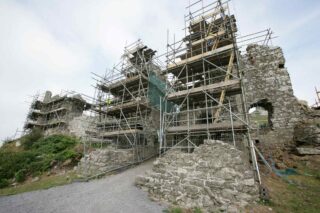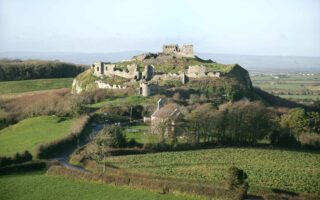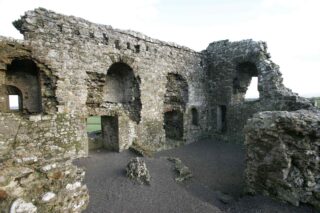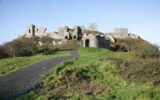Dunamase Castle is one of the most dramatically and strategically sited castles in the country, standing as it does on this massive limestone outcrop, some four miles east of Portlaoise. On 27 October, 2006 the Minister of State with Special Responsibility for the Office of Public Works, Mr.Tom Parlon, T.D, visited the site to officially mark the completion of the conservation project undertaken by the Office of Public Works under the built heritage element of the National Development Plan 2000–2006.


Dunamase originated as Dún Másc, an early medieval dún, which is mentioned in the annals for the year 843/4, when it was plundered by the Vikings. Part of the early medieval dry-stone walls of the dun are still evident today on the south-east approach to either side of the surviving gatehouse. Further evidence of the site’s occupation during this period came with the finding of a 9th century silver penny during archaeological excavations in the 1990’s.
The arrival of the Normans in the late 12th century saw a refortification of the rock and there are two surviving elements from this period: the hall at the top of the hill and a gate-tower into the lower ward. The early history of the castle remains obscure and the four people for whom cases can be made as founder of the first castle are Strongbow,William Marshal,Meyler FitzHenry and Geoffrey de Costentin.
In the early part of the 13th century the defences were remodelled entirely in stone using a more aggressive form of defence and in this phase some cut sandstone was used around the doorways, loops and portcullis slot. The entire circuit of the hilltop was enclosed with the stone curtain wall.

It is thought that the sallyport, or postern gate,was built at this time also. The sallyport would have allowed the defenders to rush out, strike at the enemy and retreat behind the safety of this heavilyfortified side door. However, much of the detail of this two-storey structure has been lost due to the collapse of earth and masonry in this area.
The excavated evidence suggests that Dunamase was abandoned by the middle of the 14th century and indeed the historical sources stop in the 1330s. It is thought that Dunamase returned into Irish hands in the late 14th century when the O’Mores took over the lands at Dunamase, but there is no evidence that the buildings were used.
It is not clear exactly when the destruction of the castle took place but it was probably not a single event. It is likely that some of the damage was caused by gunpowder and Cromwell’s forces have been implicated in the slighting of the castle.With the establishment of Fort Protector in what is now Portlaoise, a large castle in reasonable repair within four miles of this might have been seen as a threat and this proximity may have sealed its fate.
Towards the end of the 18th century, Sir John Parnell attempted to restore the castle for use as a banqueting hall and brought in architectural details from other ruins, incorporating some into the building and leaving others lying around unused. His son allowed the castle to fall into its final decay and in 1986 the castle was transferred to the State by Lord Congleton.

In the mid-1990s a series of archaeological investigations was undertaken by Brian Hodkinson on behalf of the OPW and the excavations greatly expanded the knowledge of the chronology of the site.Over 5,500 archaeological objects were recovered over the course of these excavations. However, the nature of the site, a dry limestone outcrop, meant that wooden, plant and leather materials for the most part did not survive. Items found at the site include iron weapons and armour, with arrowheads, iron door furniture and horse equipment as well as an assortment of copper alloy stick and ring pins and ten medieval coins.
The excavations by their nature left the site in an even more fragile state than previously and a programme of consolidation works was essential to stabilise the remaining structures.To this end a programme of conservation works was drawn up by Mr Timothy Foley of Buchan Kane Foley Architects and J Rainey and Co Ltd were the contractors engaged to undertake these works. The national monuments workforce based in Kilkenny also played a big part in ensuring the completion of the project on time, bringing its patience, dedication and attention to detail to bear on the site.
The primary work undertaken at Dunamase was the conservation of all the masonry structures.The most fragile of these were the areas uncovered during the archaeological excavations, particularly those in the area of the gate tower and the inner ward.The other elements of the project were the provision of safe access; ensuring as far as possible the safety of visitors once on the site; the presentation of the site and the provision of information panels relating to the history of the site. The total cost to date of the project is some €1.6million.

